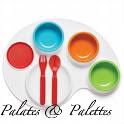Madhubani Paintings
Madhubani paintings, (also referred to as Mithila Art as it flourishes in the Mithila region of Bihar), are characterized by line drawings based on mythological themes, in bright colours and decorative borders. They are so called because they originated in and around a large agricultural town in Bihar, Madhubani or 'Forest of Honey'.
Originally, Madhubani Paintings were executed on freshly plastered mud walls, on religious occasions or weddings. Each painting was a prayer and an accompaniment to meditation. Well executed paintings were believed to be inhabited by the deities depicted in them. The colors used in these paintings were made from natural dyes. Today, Madhubani Paintings are made on silk, handmade paper, cloth, canvas etc for commercial purposes. The use of chemical dyes and paints have resulted in brighter multicolored paintings.
Madhubani art came to the notice of the rest of the country in the 1960s. Bihar had been hit by a terrible drought and the government decided to promote Madhubani Paintings to create an alternative non agricultural source of earning. The All-India Handicrafts Board encouraged the artists of Madhubani to paint on Handmade paper instead of on walls. Since then, painting has become a primary source of income for scores of families.
Madhubani paintings are mostly made by Hindu village women who traditionally passed on this skill from mother to daughter.
There is a caste hierarchy involved in the making of Madhubani paintings. The Brahmins, people of the highest caste, can depict images of Gods and Goddesses and use all kinds of bright colours such as red, yellow, blue and lemon. The second in the hierarchy are the Kayasthas, who are also allowed to paint religious themes and motifs, but may use only red and black colors. The lowest caste, called the Dusadhs, are not permitted to make religious paintings. Their style of painting called the Godhna or Tattoo art usually depicts flora and fauna in repetitive motifs.
Even today, most of the Madhubani artists' work remains anonymous. Few women like to mark their paintings with their names, and are quite reluctant to consider themselves individual producers of "works of art".
Madhubani paintings usually revolve around mythological themes (Hindu deities such as Krishna, Rama, Siva, Durga, Lakshmi, Saraswati, Sun, Moon and Tulasi) and socio-cultural themes (court scenes, wedding scenes, social happenings). The subjects most commonly depicted include sun, moon, birds, fish, and bidh-bidhata (a male and a female bird facing each other), patia (mat woven from mothi), nag-nagin (entwined male and female cobras), pan ka ghar (leaf house) and naina jogin (Goddess with magical powers). Flowers, birds, animals and geometrical designs are interspersed throughout the painting.
One trait that diffrentiates Madhubani Paintings from warli painting and other forms of Indian folk art is that they have no empty spaces – the artist covers every inch of his canvas with motifs. Like Warli Paintings, Madhubani paintings also they look two-dimensional or flat.
Traditionally Madhubani paintings were always made with natural dyes. Black was obtained by mixing soot with cow dung; yellow from turmeric or pollen or lime and the milk of banyan leaves; blue from indigo; red from the kusam flower juice or red sandalwood; green from the leaves of the wood apple tree; white from rice powder; orange from palasha flowers.














0 comments:
Post a Comment